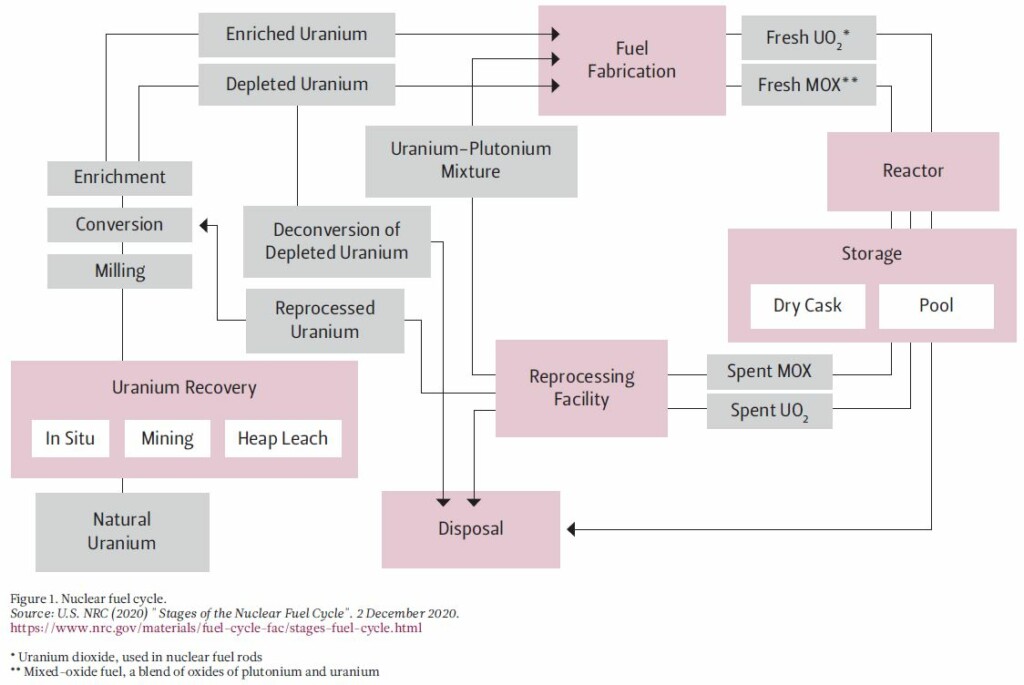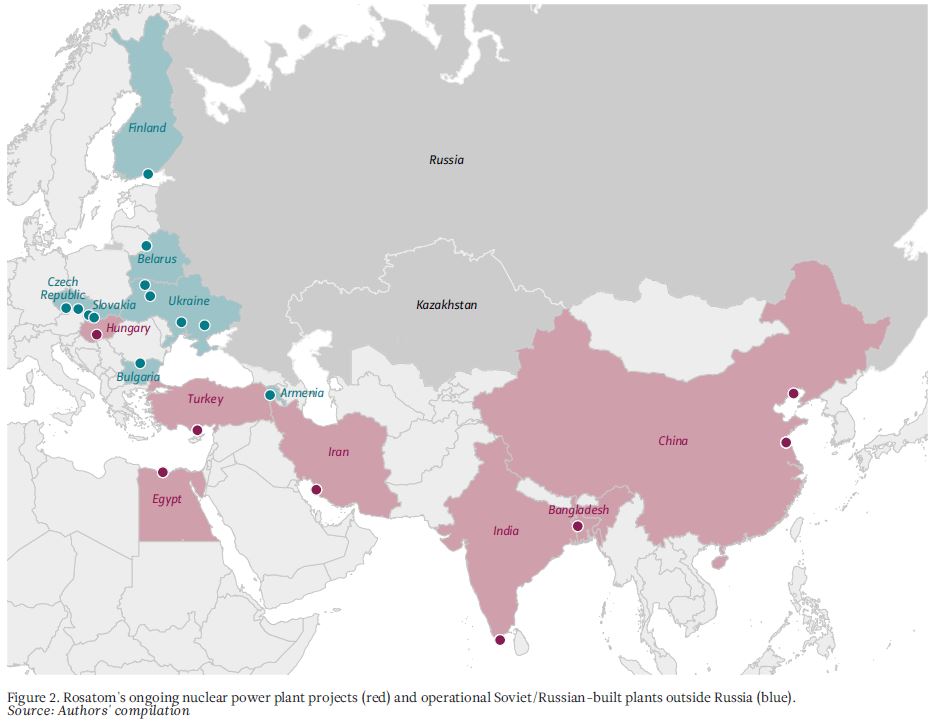yhteenveto
Useat valtiot, etenkin Kiina ja monet globaalin etelän maat, ovat päättäneet investoida ydinvoimaan, joka nähdään turvallisena ja vähäpäästöisenä vaihtoehtona fossiilisille polttoaineille. Prosessin taustalla vaikuttavat globaalin geopoliittisen kilpailun kiihtyminen ja energiasiirtymä kohti vähähiilisiä järjestelmiä.
Kazakstan on maailman suurin rikastamattoman uraanin tuottaja ja viejä, joka on toimittanut uraania länsimaihin vuosikymmenten ajan. Maan ydinsektorilla on kuitenkin tiiviit yhteydet Venäjälle, mikä on herättänyt huolta Euroopan unionissa ja Yhdysvalloissa.
Venäjä on ydinalalla merkittävä toimija, sillä se vie rikastettua uraania ja ydinteknologiaa kaikkialle maailmaan. Venäjän valtion omistamalla ydinvoimayritys Rosatomilla on laaja kansainvälinen asiakaskunta sekä lukuisia projekteja, pääasiassa länsimaiden ulkopuolella. Venäjän ydinsektorista onkin tullut tärkeä osa maan energiadiplomatiaa.
Ydinsektori on toistaiseksi säästynyt pakotteilta. Geopoliittiset jännitteet ja epävakaus uraanin tuottajamaissa ovat kuitenkin lisänneet toimitusketjuriskejä myös länsimaissa, joiden uraanin ja ydinpolttoaineen saanti on riippuvainen tuonnista.
Introduction
The Russian invasion of Ukraine has had strong repercussions on global energy markets. The prices of gas and oil increased significantly in the first half of 2022 due to the war, Western sanctions imposed on Moscow and the Kremlin’s decision to restrict gas exports to the West. While prices slowly decreased later in the year and in 2023, uncertainty about the future of energy flows persists due to geopolitical tensions, embargoes and Western price caps. Combined with the need to transition to a low-carbon economy and tackle climate change, turmoil in the fossil fuel sector has led numerous countries to accelerate the deployment of renewable energy. Some states have decided to invest in nuclear energy, seeing it as a secure and low-emission alternative to fossil fuels.
While the nuclear sector has been spared from sanctions so far, it is also affected by geopolitical considerations. Russia is a key player in the field thanks to its global exports of enriched uranium and nuclear technology. Several Western countries import Russian enriched uranium, and a few EU members operate nuclear power plants based on Soviet/Russian technology. In turn, Kazakhstan, a country politically and economically close to Russia, is the world’s largest uranium producer and exporter, accounting for almost half of global uranium production from mines in 2022. It also provides 20% of the EU’s and 22% of the US uranium imports.
Natural uranium, containing approximately 0.7% of isotope uranium-235 (U-235), is the mineral at the start of the supply chain for nuclear power. To be used as nuclear fuel, the percentage of U-235 must be increased to 3–5% through enrichment. The nuclear fuel cycle is described in more detail in Figure 1. Few states have the capacity to produce enriched uranium, and Russia has nearly half of the world’s enrichment capacity (the remaining capacity is located in Germany, the Netherlands, the United Kingdom (UK) and the US). According to some estimates, around half of Kazakhstan’s uranium goes to China, while the rest is exported to Canada, Europe and the US. Amidst Russia’s invasion of Ukraine, uranium prices have gone up markedly. In 2022, the World Nuclear Association estimated that the global demand for uranium would grow by 27% through 2030.[1]

In July 2023, a coup d’état in Niger added to Western concerns regarding the nuclear supply chain. Niger provides around 25% of the EU’s uranium imports. Wary of Russian influence over the coup leaders, some Western analysts have noted that up to 60% of global uranium production could fall under the control of Moscow and countries with significant ties to Russia.[2]
This paper explores the supply chain of the nuclear sector in Kazakhstan and Russia, from uranium extraction to enrichment, fuel fabrication and technology export. It focuses on the political significance of the two countries’ roles and the implications for Western energy security. It shows that, price fluctuations aside, uranium trade has so far remained relatively unaffected by the war in Ukraine. However, Western companies have begun to seek routes not controlled by Russia to import Kazakhstan’s uranium. They have also sought ways to replace Russian nuclear fuel in their nuclear power plants (NPPs).
The paper argues that Kazakhstan and Russia will retain a central role in the global nuclear sector thanks to their diversified portfolio of international partners. Most of Rosatom’s orders for the construction of new plants are in non-Western countries, where the company’s flexible business model and financial support have enabled it to outclass competitors. In the Global South, nuclear power has significant potential for expansion due to growing energy demand and the concomitant need to limit greenhouse gas emissions. As the West loses its leadership in the civilian nuclear sector, states interested in developing nuclear energy will be inclined to forge closer cooperation with Russia. Meanwhile, the Western nuclear energy sector continues to rely on supplies and services from Kazakhstan and Russia. While uranium and nuclear fuel trade has not been utilised to exert political pressure thus far, geopolitical tensions and instability in producing countries have increased security of supply risks for the West.
Kazakhstan’s uranium sector
Kazakhstan’s abundant uranium resources were discovered in the 1950s when the country was still an integral part of the former Soviet Union. The deposits were used for the Soviet nuclear weapons programme while several mining complexes, three production plants, one major testing site and numerous other facilities were built. In the late Soviet era, increased public awareness about the tragic effects of nuclear testing generated an outcry across Kazakhstan. Soon after the collapse of the USSR, newly independent Kazakhstan decided to close the Semipalatinsk testing site, ban all tests in its territory and sign the Treaty on the Non-Proliferation of Nuclear Weapons (NPT). The nuclear arsenal inherited from the USSR was transferred to Russia, and the related military infrastructure was dismantled in collaboration with the US and the International Atomic Energy Agency (IAEA).
However, thanks to the uranium deposits and the infrastructure and expertise inherited from the USSR, the Kazakh nuclear industry emerged in the 2000s as a profitable field, well connected to global markets. The activities related to the nuclear fuel cycle in Kazakhstan are operated by the state company Kazatomprom, 75% of which is owned by the Kazakh government through the national sovereign wealth fund Samruk-Kazyna. Kazakhstan’s limited uranium processing and reconversion services as well as fuel pellet production are run by Kazatomprom’s subsidiary, the Ulba Metallurgical Plant, in collaboration with foreign actors.
At present, Kazakhstan hosts 13 uranium mining projects, three of which are entirely owned by Kazatomprom, and ten are joint ventures with owners from Canada, China, France, Japan and Russia. In 2022, Kazakhstan produced the largest share of uranium from mines (22,000 tonnes or 43% of world supply), followed by Canada (15%) and Namibia (11%). Kazakhstan’s output is expected to remain at the current level in the foreseeable future.[3] The method of mining in Kazakhstan’s mines, in situ leach, is considered the most cost-effective.
Kazakhstan’s government is open to foreign investments and global trade flows. Although Astana is one of Moscow’s closest political and economic partners, it has not publicly endorsed Russia’s war in Ukraine and has pledged not to violate Western sanctions imposed on Moscow. However, Russia’s presence in Kazakhstan’s nuclear sector remains strong. Uranium One, the company managing Rosatom’s foreign uranium mining assets, holds stakes ranging from 30% to 70% in companies operating six different mines.[4]
The war in Ukraine has had some effects on Kazakhstan’s uranium sector. On the one hand, business as usual continues with Russia: in May 2023, Rosatom acquired a 49% stake in the Budenovskoye mine, which is expected to become the world’s biggest source of uranium. On the other hand, Kazakhstan’s leadership is exploring new export routes that would allow them to reach world markets while bypassing Russia’s territory. The most viable route to the West seems to be the Trans-Caspian International Transport Route (TITR) via Azerbaijan, Georgia and Turkey. Kazatomprom used this route to deliver natural uranium to Canada in autumn 2022. Although the TITR suffers from major bottlenecks, Astana seems hopeful about the corridor’s future.[5]
Collaboration with China has increased since the outbreak of the war in Ukraine. Not only has Kazakhstan increased its exports to China due to growing demand, but it has succeeded in moving higher up in the value chain. In December 2022, a Kazakh-Chinese joint venture made its first delivery of fuel assemblies to nuclear power stations in China. However, while the uranium for the fuel assemblies was indeed processed at the wholly Kazatomprom-owned Ulba Metallurgical Plant, it was sourced from Russia.
This case reflects the intertwined nature of the Kazakhstani-Russian nuclear sector. Kazakhstan relies on Russia for the conversion of uranium ore into nuclear fuel. Close cooperation with Russia has formed the core of its nuclear strategy since the early 2000s and is one of the reasons why the industry flourishes today. Rosatom might be selected to construct Kazakhstan’s first nuclear power plant despite public concerns about the potential political cost of such a deal and the safety of the NPP. The issue has been brought up in bilateral government meetings for years, and the latest statements of Kazakhstan’s Minister of Energy, Almasadam Satkaliev, remain mixed. In July 2023, he stated that the construction of the NPP is “a commercial, not a political project”, while only three months before, he had noted that “the geopolitical aspects of construction must be acknowledged”.[6]
Kazakhstan’s close relationship with Russia is an issue that the West must factor in when deciding how to develop its energy partnership with Astana. The country has been a reliable commercial partner for the EU and the US but remains vulnerable to Russian pressure. In addition, Kazakhstan’s authoritarian mode of governance and widespread corruption continue to generate domestic instability. Energy revenues are the primary source of the ruling elite’s illicit wealth and thus the focus of public grievances. Public criticism is primarily targeted towards the fossil industry, but the nuclear fuel sector is not immune to allegations of corruption. In 2010, one of the country’s most prominent business figures, Mukhtar Dzhakishev, was arrested on accusations of corruption, theft and illegal sale of uranium assets to foreign companies.
Russia’s nuclear sector
Russia’s nuclear sector dates back to the Second World War when Soviet military plans drove its development. By the 1980s, the Soviet Union had installed 37 GW of capacity in nuclear power, deploying two types of reactors: the pressurised water reactor VVER and the graphite-cooled reactor RBMK. Modern versions of the former are the anchor of the Russian nuclear industry today. In addition, the Soviet Union built plants and reactors in Bulgaria, Czechoslovakia, East Germany, Finland and Hungary. The legacy of the Chernobyl nuclear disaster in 1986 and the economic crisis of the 1990s hindered the development of the Russian nuclear industry. However, in the late 1990s and 2000s, new projects were launched both in Russia and abroad, allowing the industry to retain its capabilities and human resources. The State Atomic Energy Corporation Rosatom was established in 2007.
Rosatom is structured as a vertically integrated corporation that controls (either directly or via subsidiaries) the full cycle of competences in the nuclear sector, from uranium mining to the construction and operation of nuclear power plants, including processing and storage of spent fuel. Rosatom is also responsible for Russia’s nuclear weapon division, nuclear-powered icebreaker fleet and nuclear research institutions, as well as for ensuring nuclear and radiation safety.[7] In recent years, the company has expanded its activities to the renewable energy sector, notably wind power.
In Russia, Rosatom operates 38 nuclear power reactors in 11 NPPs, most of which are located in the European part of Russia. The NPPs account for approximately 20.7% of Russia’s electricity generation. The latest Federal Target Programme envisages a 25–30% nuclear share in electricity supply by 2030, rising to 45–50% by 2050 and 70–80% by the end of the century.[8]
Nuclear technology is one of the few high-tech sectors in which Russia is a world leader. The country is investing in the development of new reactor technologies. These include safe plants using fast neutron reactors, MOX (a blend of oxides of plutonium and uranium) and a closed fuel cycle, which would eliminate the production of radioactive waste from power generation. Currently, Russia is the only viable commercial supplier of high-assay, low-enriched uranium (with 5–20% concentration of the isotope U-235 instead of the 3–5% concentration that fuels the existing fleet of light water reactors), which will be needed to power the new generation of advanced reactors.[9]
Rosatom’s foreign portfolio and nuclear energy diplomacy
Rosatom’s portfolio of foreign orders includes reactor construction, fuel provisions and other services, and spans 54 countries. Rosatom’s projects are at very different stages of development. They range from plants in operation to ongoing, contracted or planned construction of reactors, invitations to partnerships and memoranda of understanding for services. Between 2009 and 2018, the company received 23 of the 31 global orders and was responsible for half of all reactors under construction worldwide. Moreover, through its subsidiary TVEL, Rosatom controls 38% of global uranium conversion and 46% of uranium enrichment capacity. Many Western countries, including France, Japan, South Korea, the UK and the US, have contracts with Rosatom for enrichment services. The US relies on Rosatom and Russian-controlled supply chains for nearly half of its nuclear fuel supply, and 40% of the EU’s imports come from Russia.[10]
Russia’s key role in the Western nuclear fuel market is the result of two main factors. Firstly, Russian engineers developed a system to enrich uranium that is significantly less energy-intensive and thus much cheaper than the method used by American and French engineers. Secondly, in 1993, Russia and the US agreed to the so-called “Megatons to Megawatts” programme, in which the highly enriched uranium from former Soviet nuclear warheads was transformed into low-enriched uranium and shipped to the US for civilian nuclear plants. As a result, the US industry could not compete against Russian fuel.[11]
The strength of Rosatom’s export strategy for reactors and whole NPPs lies in its ability to provide all-inclusive packages. The company offers plant construction know-how, training, support related to safety, non-proliferation regime requirements, flexible financing options (including Russian government loans) and handling of spent nuclear fuel (taking the spent fuel from overseas clients to temporary storage and reprocessing in Russia). This makes it particularly attractive to newcomers in the civilian nuclear power sector and explains Rosatom’s surging business in Africa, Asia, the Middle East and South America. Its business model has enabled it to outclass Western competitors, which normally require robust financial guarantees and partnership arrangements with clients as part of their corporate business standards. Currently, Rosatom is building reactors in Bangladesh, China, Egypt, Hungary, India, Iran and Turkey, as shown in Figure 2.
Rosatom’s foreign activities receive the full support of the Russian government, including during bilateral meetings between representatives of the partner country and the Russian president or senior members of government. Cooperation on the peaceful use of nuclear energy is included in the agenda, mentioned in public speeches and sometimes codified in memoranda of understanding. When cooperation reaches an advanced stage, the Russian president or senior Russian government members attend official ceremonies with their foreign counterparts and celebrate landmarks in the construction of new projects.
Rosatom also makes special offers to strategic partners, as in the case of Turkey’s Akkuyu NPP. This is the first plant where the company offered a build-own-operate model, under which it retains majority ownership and a guaranteed price on electricity sales but bears all the financial, construction and operational risks. It is however questionable whether this model can be easily replicated. While Russian experts have highlighted high costs for Rosatom (at least $22 billion), Western critics fear the security implications of the plant, which has de facto extraterritorial status. Yet, the project is going ahead with the recent inauguration of the first of the four planned reactors, which are expected to provide 10% of Turkey’s electricity needs.[12]
In the EU, following Russia’s invasion of Ukraine, Finland and Slovakia cancelled contracts with Rosatom to build new NPPs and reactors, whereas Hungary has not changed its plans. Budapest is receiving a $10 billion loan from Russia for the construction of two new reactors at its Paks NPP.[13] In addition, Rosatom supplies nuclear fuel to plants in Bulgaria, the Czech Republic, Finland, Hungary and Slovakia; these countries operate 18 Soviet- and Russian-designed reactors that must be reloaded with fuel approximately every two years. While the reactors have so far operated only with Russian-produced fuel, Western companies have developed fuel that can replace Rosatom’s supplies, with Ukraine recently operating this switch in some of its NPPs.[14] In January 2023, the EU started co-funding the Accelerated Program for Implementation of Secure VVER Fuel Supply (APIS), which should develop and deliver a fully European nuclear fuel supply for Russian-designed VVER reactors.
Overall, the current and projected reliance on Russian nuclear services varies substantially among Rosatom’s partner states. According to estimates, by 2040, the dependence on electricity produced by Rosatom’s reactors will be high in Armenia (100%), Hungary (42%), Bulgaria (37%), Belarus (34%) and Uzbekistan (20%). Reliance on Russian reactors is particularly significant in countries that base their decarbonisation efforts primarily on nuclear energy (i.e., Hungary and Slovakia in the EU), and where the power system is inflexible and over-reliant on a single large NPP. Conversely, dependence on Rosatom appears marginal in China and India, which already have domestic nuclear industries and expect to receive only a small share of their electricity from Rosatom-built reactors.[15]
Conclusions
This paper has highlighted Russia’s and Kazakhstan’s central role in the global nuclear energy sector. Kazakhstan is currently the biggest uranium exporter globally. Its nuclear sector is deeply interlinked with that of Russia, but the country also has entrenched commercial partnerships with China and a group of Western actors, notably Canada, France and Japan. Amidst the war in Ukraine, Western countries are concerned about Kazakhstan’s vulnerability to pressure from Moscow and have been trying to strengthen supply routes for Kazakh uranium that circumvent Russia.
Russia is a major actor in all aspects of the nuclear sector, from uranium mining to enrichment, NPP construction and processing of spent fuel. Its state nuclear energy company Rosatom has a large global portfolio and a competitive edge over Chinese and Western companies thanks to its flexible business model and technological capabilities. Rosatom’s global activities have continued despite the war in Ukraine. Most of its new projects are in non-Western countries that continue to do business as usual with Moscow. Western sanctions on Rosatom’s activities seem unlikely for now. The main reasons for this are the lack of commercial alternatives and the risk that no other supplier is prepared to operate Russian-built NPPs, thus leading to stranded assets and serious gaps in electricity supply.
Overall, Russia’s nuclear sector has become an important aspect of its great power status-seeking, enabling Moscow to make unique offers to clients worldwide in the strategic field of low-carbon energy generation. As long as energy demand increases outside the West, and nuclear power is seen as an important part of the future energy mix, Rosatom will remain a leading player and a powerful factor in Russia’s energy diplomacy.
For the West, the issue of securing uranium supplies has become more salient in the summer of 2023, following the coup d’état in Niger. Niger’s new military leaders have been described as anti-Western and have reportedly sought the assistance of Russian mercenary group Wagner. The global supply chains of uranium might well become more politicised and unpredictable in the future.
Endnotes
[1] World Nuclear Association (2023) “World Uranium Mining Production”, https://www.world-nuclear.org/information-library/nuclear-fuel-cycle/mining-of-uranium/world-uranium-mining-production.aspx; and “Uranium Markets”, https://www.world-nuclear.org/information-library/nuclear-fuel-cycle/uranium-resources/uranium-markets.aspx.
[2] Blas, Javier (2023) “The Long Arm of the Kremlin and the Politics of Uranium”. Bloomberg, 3 August 2023, https://www.bloomberg.com/opinion/articles/2023-08-03/niger-coup-the-long-arm-of-russia-and-the-politics-of-uranium.
[3] World Nuclear Association (2023) “Uranium and Nuclear Power in Kazakhstan”, https://world-nuclear.org/information-library/country-profiles/countries-g-n/kazakhstan.aspx; Gizitdinov, Nariman (2023) “World’s Top Uranium Miner Sees Clients Switching From Russia”. Bloomberg, 11 April 2023, https://www.bloomberg.com/news/articles/2023-04-11/world-s-top-uranium-miner-sees-clients-switching-from-russia.
[4] Interfax (2023) “Rosatom transferring stakes in three uranium JVs with Kazakhstan to Russian entity”, 28 February 2023, https://interfax.com/newsroom/top-stories/88300/.
[5] Sánchez, Wilder Alejandro (2023) “Kazakhstan’s Uranium Industry and the Middle Corridor Come Together”. The Diplomat, 30 January 2023, https://thediplomat.com/2023/01/kazakhstans-uranium-industry-and-the-middle-corridor-come-together/.
[6] TASS (2023) “Glava Minenergo Kazakhstana otmetil preimushchestvo Rosatoma v atomnoi industrii”, 11 April 2023, https://tass.ru/ekonomika/17494039; News.ru (2023) “V Kazakhstane vyberut kandidata iz piati stran dlia stroitel’stva AES”, 28 July 2023, https://news.ru/cis/v-kazahstane-vyberut-kandidata-iz-pyati-stran-dlya-stroitelstva-aes/.
[7] Schepers, Névine (2019) “Russia’s Nuclear Energy Exports: Status, Prospects and Implications”. SIPRI, 2019, 2, https://www.sipri.org/sites/default/files/2019-02/eunpdc_no_61_final.pdf.
[8] IAEA (2021) Country Profile: Russian Federation, https://cnpp.iaea.org/countryprofiles/Russia/Russia.htm.
[9] Lorenzini, Marina and Francesca Giovannini (2022) “Five reasons that Russia’s nuclear exports will continue, despite sanctions and the Ukraine invasion. But for how long?” Bulletin of the Atomic Scientists, 17 May 2022, https://thebulletin.org/2022/05/five-reasons-that-russias-nuclear-exports-will-continue-despite-sanctions-and-the-ukraine-invasion-but-for-how-long/.
[10] Cited in Szulecki, Kacper and Indra Overland (2023) “Russian nuclear energy diplomacy and its implications for energy security in the context of the war in Ukraine”. Nature Energy 8: 413–416.
[11] Blas 2023.
[12] Al Jazeera (2023) “Erdogan thanks Putin for his help on Turkish nuclear plant”, 27 April 2023, https://www.aljazeera.com/news/2023/4/27/putin-erdogan-speak-before-inauguration-of-turkish-nuclear-plant.
[13] Aalto, Pami et al. (2017) “Russian nuclear energy diplomacy in Finland and Hungary”. Eurasian Geography and Economics 58(4): 386–417.
[14] However, operating this switch in the EU would likely take at least five years. See World Nuclear News (2023) “Westinghouse to enhance safety of Ukrainian VVER-440s”, 14 June 2023, https://www.world-nuclear-news.org/Articles/Westinghouse-to-enhance-safety-of-Ukrainian-VVER-4.
[15] Szulecki and Overland 2023, 145.



